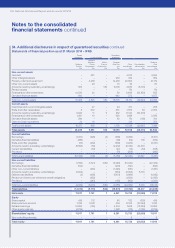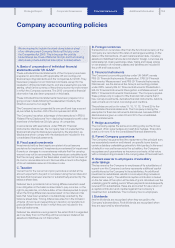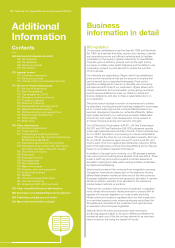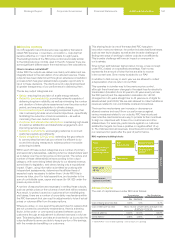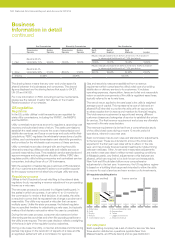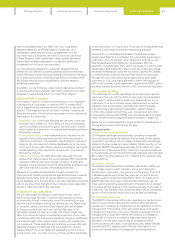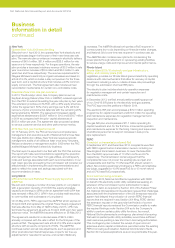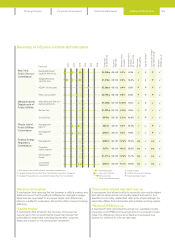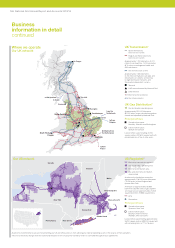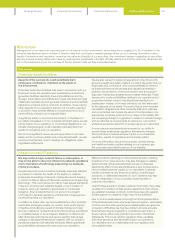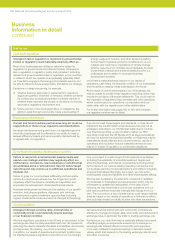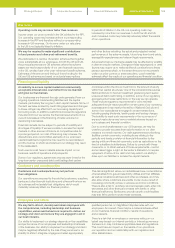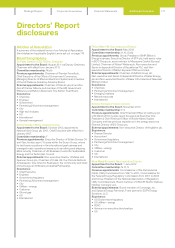National Grid 2014 Annual Report Download - page 164
Download and view the complete annual report
Please find page 164 of the 2014 National Grid annual report below. You can navigate through the pages in the report by either clicking on the pages listed below, or by using the keyword search tool below to find specific information within the annual report.
Gas and electricity rates are established from a revenue
requirement which comprises the utility’s total cost of providing
distribution or delivery service to its customers. It includes
operating expenses, depreciation, taxes and a fair and reasonable
return on certain components of the utility’s regulated asset base,
typically referred to as its rate base.
The rate of return applied to the rate base is the utility’s weighted
average cost of capital. This represents its cost of debt and an
allowed RoE intended to provide the utility with an opportunity
toattract capital from investors and maintain its financial integrity.
The total revenue requirement is apportioned among different
customer classes and categories of service to establish the prices
for service. The final revenue requirement and prices are ultimately
approved in the rate case decision.
The revenue requirement is derived from a comprehensive study
of the utility’s total costs during a recent 12 month period of
operations, referred to as a test year.
Each commission has its own rules and standards for adjustments
to the test year. These are intended to arrive at the total costs
expected in the first year new rates will be in effect, or the rate
year, and may include forecast capital investments in determining
rate year rate base. Often, known and measurable adjustments
are made to test year data to reflect normal operating conditions.
In Massachusetts, only limited adjustments to this test year are
allowed, which are required to be both known and measurable.
New York and Rhode Island allow more comprehensive
adjustments to the test year. In summary, the US regulatory regime
is based on a building block approach intended to allow the utility
to recover its cost of service and earn a return on its investments.
US regulatory building blocks
A B C D E F G H I J
Capex and RoE Cost of service
A Rate base
B Debt
C Equity
D Return
E Controllable costs
F Non-controllable costs
G Depreciation
H Taxes
I Lagged recoveries
J Allowed revenue
X allowed
RoE
X cost
of debt
RoE
Interest
Our rate plans
Each operating company has a set of rates for service. We have
three electric distribution operations (upstate New York,
Massachusetts, and Rhode Island) and six gas distribution
The sharing factor means that any over- and under-spend is
shared between the businesses and consumers. The shared
figures displayed are the sharing factors that apply to UKET,
UKGT andUKGD.
For more information on RIIO, including incentive mechanisms,
please see the relevant investor factsheets on the Investor
Relations section of ourwebsite.
US regulation
Regulators
In the US, public utilities’ retail transactions are regulated by
stateutility commissions, including the NYPSC, the MADPU
andthe RIPUC.
Utility commissions serve as economic regulators, approving cost
recovery and authorised rates of return. The state commissions
establish the retail rates to recover the cost of transmission and
distribution services, and focus on services and costs within their
jurisdictions. FERC regulates the wholesale transactions of public
utilities, such as interstate transmission and electricity generation,
and provides for the wholesale cost recovery of these services.
Utility commissions are also charged with serving the public
interest by ensuring utilities provide safe and reliable service at
justand reasonable prices. They establish service standards and
approve mergers and acquisitions of public utilities. FERC also
regulates public utility holding companies and centralised service
companies, including those of our US businesses.
With the exception of residential gas customers in Rhode Island,
all of our customers are allowed to select a competitive supplier
forthe supply component of electricity and gas utility services.
Regulatory process
Utilities in the US submit a formal rate filing to the relevant state
regulatory body, requesting a revenue adjustment in a proceeding
known as a rate case.
The rate case process is conducted in a litigated setting and, in
the states in which we operate, it can take 10 to 13 months for
thecommission to render a final decision. In all states, the utility
isrequired to prove that its requested rate change is prudent and
reasonable. The utility may request a rate plan that can span
multiple years. Unlike the state processes, the federal regulator
has no specified timeline for adjudicating a rate case, but typically
makes a final decision retroactive when the case is completed.
During the rate case process, consumer advocates and other
intervening parties scrutinise and often file opposing positions to
the utility’s rate request. The rate case decision reflects a weighing
of the facts in light of the regulator’s policy objectives.
During a rate case, the utility, consumer advocates and intervening
parties may agree on the resolution of aspects of a case and file
anegotiated settlement with a commission for approval.
Gas Transmission Electricity Transmission Gas Distribution
Transmission
Operator
System
Operator
Transmission
Operator
System
Operator
North
West
East of
England
West
Midlands London
1 Fast
Baseline 35.6%
62.60% 15.00% 72.10%
Repex: Stepped decline from 50% in 2013/14 to 0% in 2020/21
in seven equal instalments of 7.14% per annum
Uncertainty 10% 73.90% 73.37% 75.05% 76.53%
2 Slow
Baseline 64.4%
37.4 0% 85.00% 2 7.9 0 %
Repex: Stepped increase from 50% in 2013/14 to 100% in 2020/21
in seven equal instalments of 7.14% per annum
Uncertainty 90% 26.10% 26.63% 24.95% 23.47%
3 Sharing 44.36% 46.89% 63.04%
Business
information in detail
continued
162 National Grid Annual Report and Accounts 2013/14


